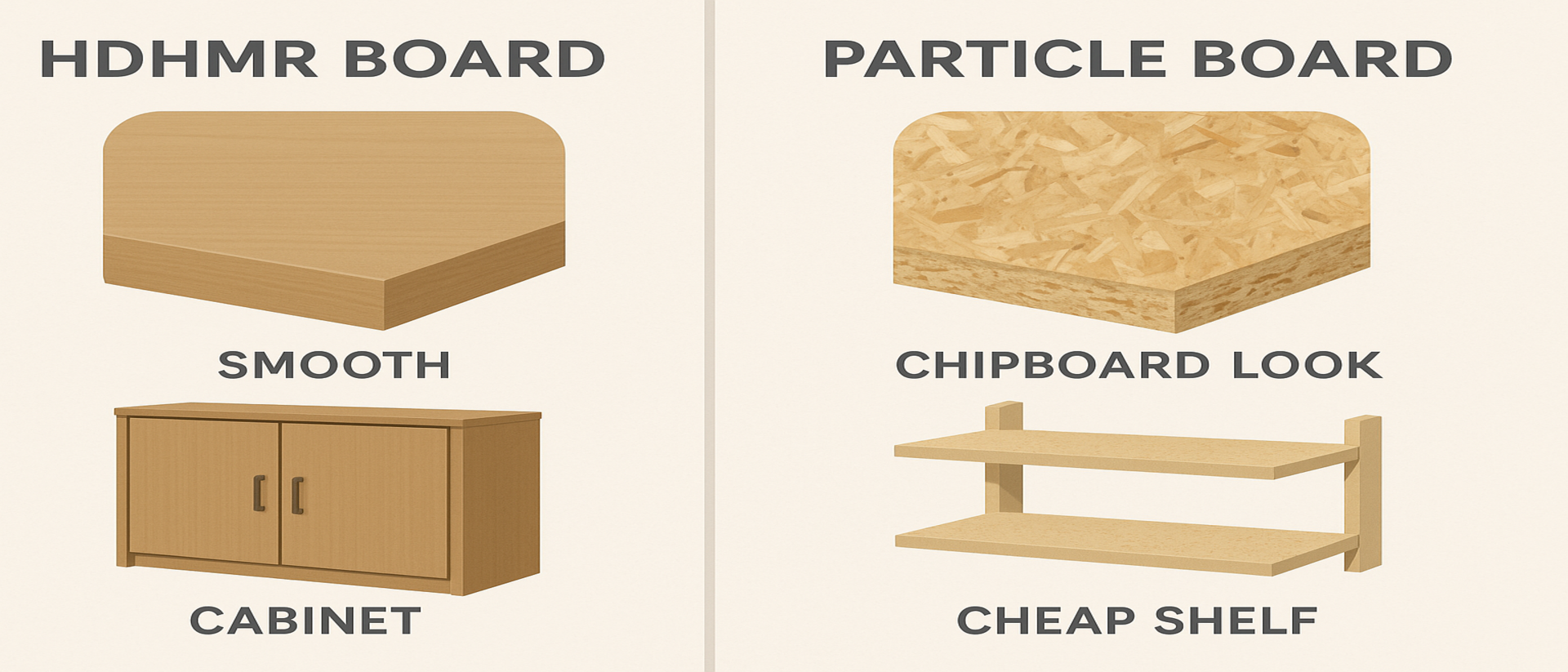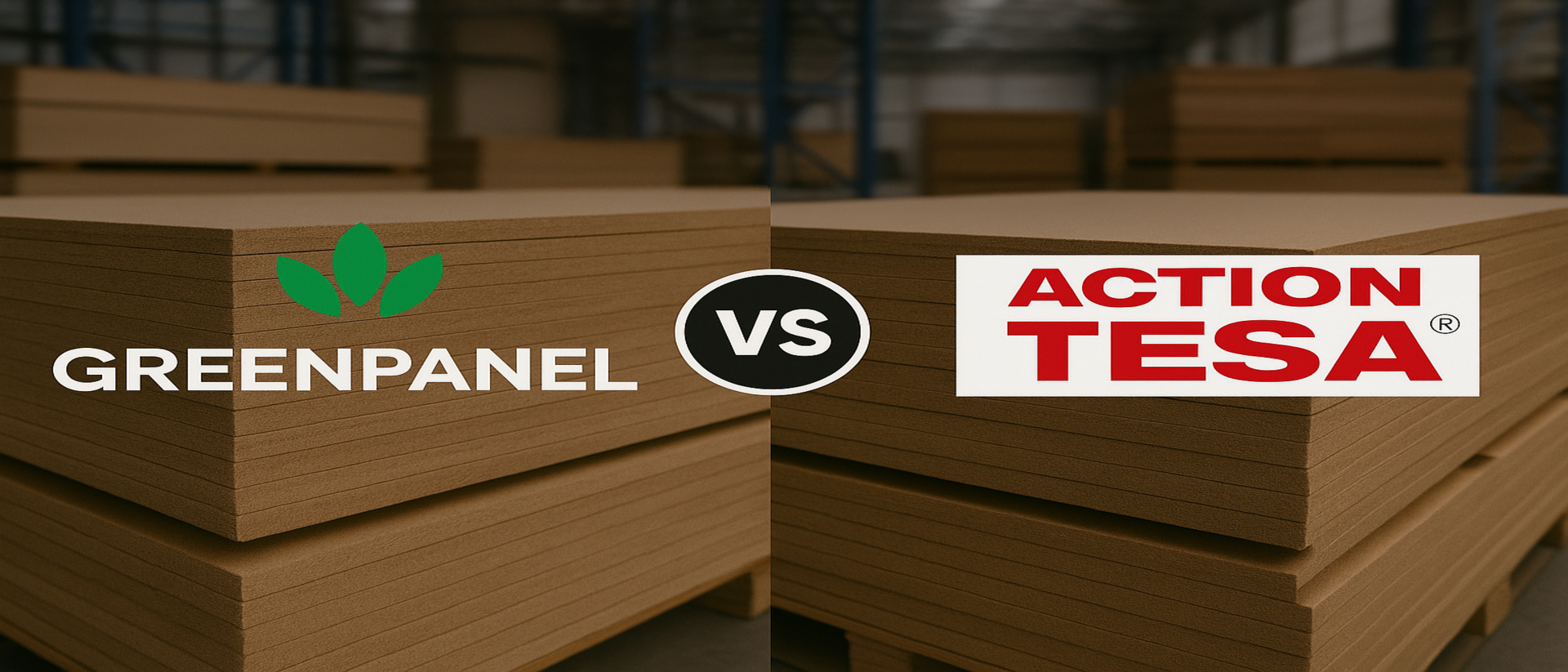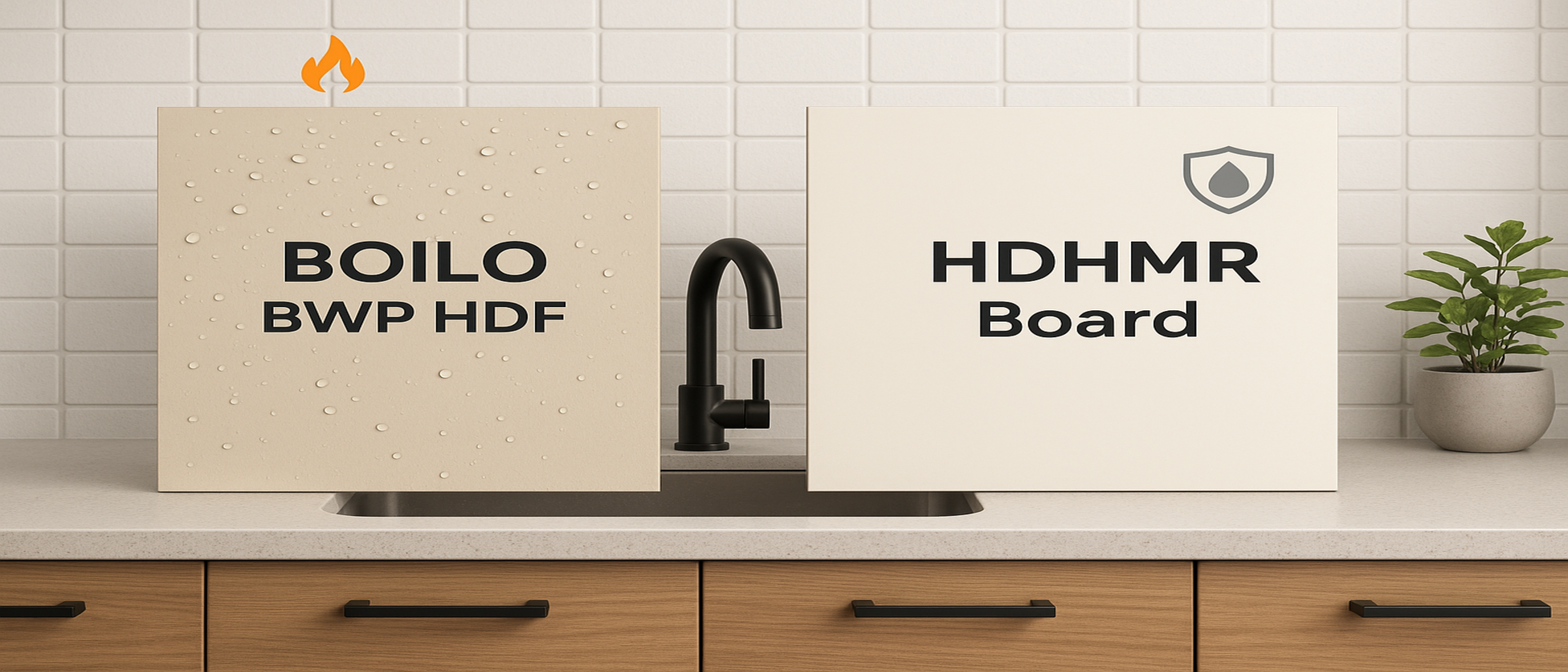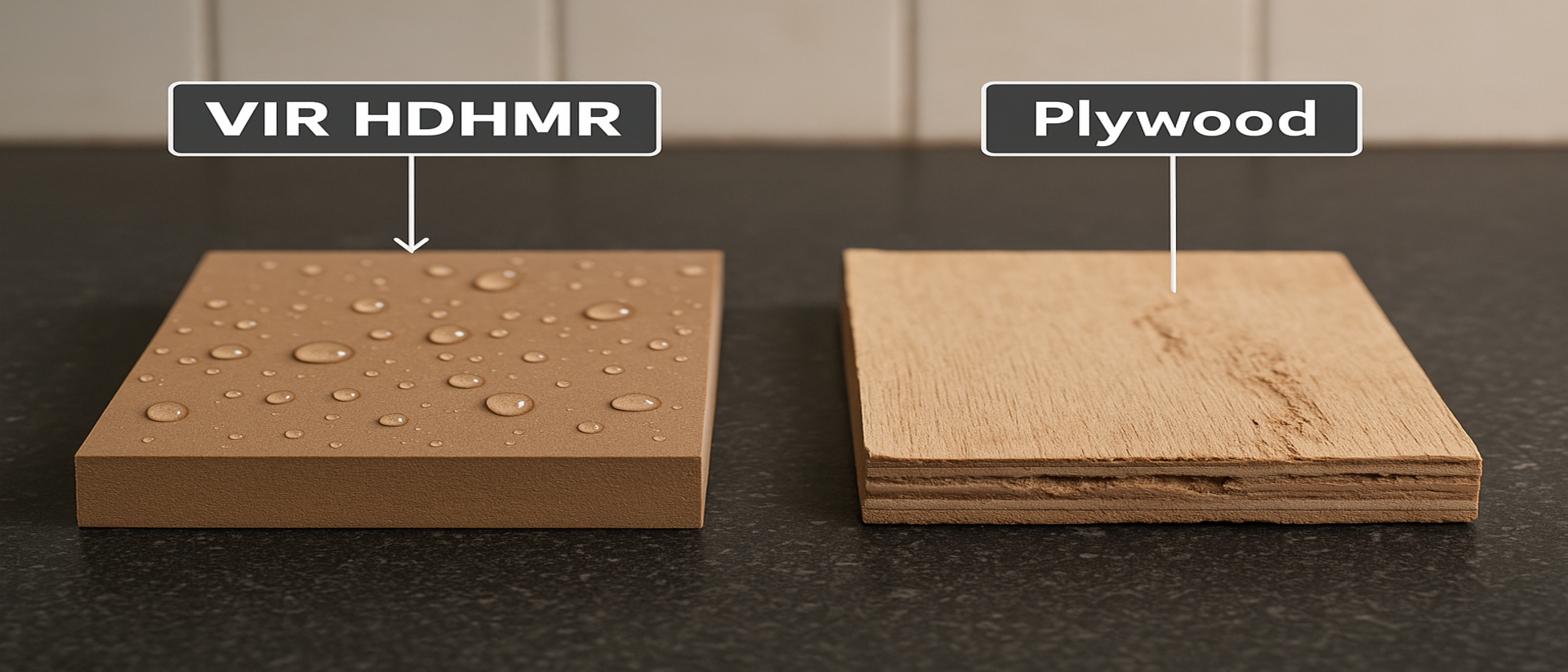Introduction
When building furniture or cabinets, material choice impacts longevity. HDHMR (High Density High Moisture Resistant board) is a premium engineered wood, while particle board is a low-cost composite of wood chips. Particle board is budget-friendly but weakens with moisture. In contrast, HDHMR is stronger and more moisture-resistant. This comparison outlines their 2025 technical specs, strengths/weaknesses, and costs so you can decide which board fits your needs.
2025 Technical Specs & Price Comparison
· Density: HDHMR is very dense (approx. 800–900 kg/m³), while particle board is light and low-density (around 600–700 kg/m³).
· Moisture Resistance: HDHMR is formulated with water-resistant resin and “handles moisture far better” than ordinary boards. Particle board has minimal moisture protection; it will swell and crumble if it gets wet.
· Screw Holding: HDHMR’s dense core offers excellent screw retention. Particle board, being loosely bonded chips, has poor screw-holding strength – screws can loosen or strip the material.
· Standard Sizes: Both come in 8×4 ft sheets. HDHMR typically in thicknesses 6–18mm; particle board is often 12mm or thicker for strength.
· Price (2025): Particle board is very cheap: roughly ₹35–50 per sq ft (12mm) on the low end. HDHMR is pricier, around ₹80–120 per sq ft. In summary, particle board costs 40–60% less than HDHMR, but this comes with trade-offs in performance.
Strengths & Weaknesses of Each Material
HDHMR Board
· Strengths: HDHMR is far stronger and stiffer than particle board. Its high density means it bears weight and pressure like hardwood. For example, a shelf made of HDHMR will hold heavy books without sagging, while a particle board shelf will bow under load. HDHMR’s uniform structure also grants excellent screw and nail holding. Unlike particle board, HDHMR resists moisture and pests, so it stays structurally sound in kitchens/bathrooms.
· Weaknesses: HDHMR is much more expensive and heavier. It can be overkill for simple, low-load uses. While it resists moisture, it still requires lamination or painting to protect its surface – untreated wood fibers can discolor over time. Also, HDHMR’s hardness means cutting it requires sharp tools; unlike particle board, it’s not easy to trim on the job.
Particle Board
· Strengths: Particle board is cheap and easy to find, making it popular for budget furniture. It’s relatively lightweight and smooth, so it can be quickly veneered or laminated. For dry, light-duty furniture (like affordable desks or shelving in a dry closet), it’s an economical choice.
· Weaknesses: In almost every performance category, particle board is inferior to HDHMR. It has low structural strength – particle board shelves must be short spans or extra-braced to avoid sagging. It virtually disintegrates with moisture: even humidity causes puffing at joints. Its screw holding is weak (edges crumble easily), and it has no termite resistance. Durability is low: most particle furniture lasts only a few years before failing.
Durability & Moisture Resistance
Particle board performs poorly under moisture. A small spill can swell and deform it within minutes. High humidity causes board edges to delaminate and crumble. Therefore, particle board is normally not used in kitchens/bathrooms. By contrast, HDHMR handles moisture very well. It’s engineered to resist humidity, so kitchen cabinets made of HDHMR remain intact during monsoons or plumbing leaks. Over time, HDHMR furniture retains its strength, whereas particle board ones may sag or break. In wear-and-tear tests, HDHMR far outlasts particle board. One expert noted HDHMR is often chosen over particle board exactly because of its “far superior strength and longevity”, making it a much more durable investment for the home.
Applications / Best Use Cases
· HDHMR: Best for long-lasting, moisture-prone and heavy-load applications. Ideal for kitchen cabinets, bathroom vanities, wardrobes, tables, and any furniture that should endure daily use. Use HDHMR where durability and a smooth finish (for paint or laminate) are needed. It’s especially recommended for high-traffic items like office furniture and playroom storage.
· Particle Board: Suited only for very light-duty, budget furniture in dry, low-moisture environments. Commonly used in temporary shelving, cheap bedroom units, or low-end office cubicles. It’s also used under a plastic laminate or veneer when cost is the overriding concern (e.g. some kitchen cabinet doors use laminated particle board). It should be kept away from any dampness – even moisture-resistant finishes only delay the inevitable swelling.
Cost Analysis & Value for Money
Particle board’s huge advantage is upfront cost: a 8×4′×12mm sheet can be only a few hundred rupees. HDHMR sheets cost well over a thousand rupees each. However, consider longevity: particle board furniture often needs replacement after just 2–5 years (especially if ever exposed to a drop of water). HDHMR furniture can last 10–20 years without issue. In cost-per-year terms, HDHMR can actually be more economical. For example, spending 2× on HDHMR may yield 5× the lifespan, saving money on rebuilds. A comparison notes that despite its higher price, HDHMR offers “cost savings in the long run” through durability. In short, particle board is cheaper now, but HDHMR provides far better value over the product’s life, as it avoids maintenance and replacement costs.
Buyer’s Checklist: Which to Choose?
· Budget vs Use: If your project is strictly limited by budget and will see little use, particle board can do a job. For any moderate to high usage (or any chance of moisture), HDHMR is worth the extra investment.
· Weight/Load: Avoid long spans of particle board; use HDHMR if shelves or tops will bear heavy items (books, electronics).
· Environment: Never use plain particle board where it might get wet. Choose HDHMR (or plywood) for kitchens, bathrooms or humid climates. Particle board is only for dry, interior use.
· Finishing: Particle board has a uniform surface great for lamination but cannot be painted without primer. HDHMR can be laminated or directly painted/veneered for a premium finish.
· Longevity: For furniture you intend to keep for many years (tables, cabinets, desks), HDHMR’s durability will repay its cost.
· Screw/Hinge Fixing: If you need to repeatedly screw/unscrew or use heavy hinges, HDHMR’s screw-retention is far superior. Particle board edges will crack under such stress.
FAQs
Q1: Can I use HDHMR instead of particle board for cupboards?
Yes. HDHMR is stronger, more moisture-resistant, and longer-lasting than particle board. While particle board might save money, HDHMR cupboards won’t sag or swell. It also holds screws better for hinges and handles. Industry sources explicitly say HDHMR outperforms particle board in every important aspect.
Q2: How much more does HDHMR cost than particle board?
Roughly 2–3× more. Particle board can be ₹35–50/sqft, while HDHMR runs around ₹80–120/sqft. The exact price depends on thickness and brand. Remember, HDHMR’s higher price buys much better performance and lifespan.
Q3: Is particle board water-resistant?
No. Standard particle board has almost no inherent water resistance. Even moisture-resistant grades will swell if soaked. HDHMR boards, by contrast, are treated with moisture-blocking resin, making them far more stable in humid conditions.
Q4: How do their weights compare?
HDHMR is much heavier because of its dense composition. Particle board is lighter and usually less than plywood’s weight. This is another trade-off: HDHMR’s weight contributes to its strength, but it makes handling large sheets more cumbersome.
Q5: Which board holds screws better?
HDHMR wins hands down. Its dense wood-fiber core grips screws tightly even at edges. Screws in particle board can loosen or strip out, especially if the board gets a bit wet or is over-tightened.
Q6: Are there applications where particle board makes sense?
Yes – if cost is the only concern and the use is extremely light and indoors. For example, cheap bedroom wardrobes, kids’ study tables (with no exposure to water), or temporary displays. But even then, many experts recommend MDF or plywood over particle for only slightly higher cost and much better performance.
Conclusion
Particle board and HDHMR serve very different needs. Particle board is an ultra-cheap, short-lived material suitable only for low-load, dry applications. HDHMR is a high-performance board built for longevity: it’s extremely strong, has superior moisture resistance, and significantly outlasts particle board. In most furniture and cabinetry projects where durability matters, HDHMR is the better investment despite the higher price. If you’re building anything for long-term use or in a humid environment, choose HDHMR. For a quote on HDHMR boards (or advice on using them instead of particle board), contact us now – we’ll help you pick the right board and get the best pricing for your project.
Disclaimer: This article is generated using AI-assisted research and is intended for informational purposes only. While we strive for accuracy, readers are advised to verify all technical, pricing, and brand-specific details with official sources. hdhmr.in is not liable for any decisions made based on this content.




